Recognizing the rapid development of Asean relations
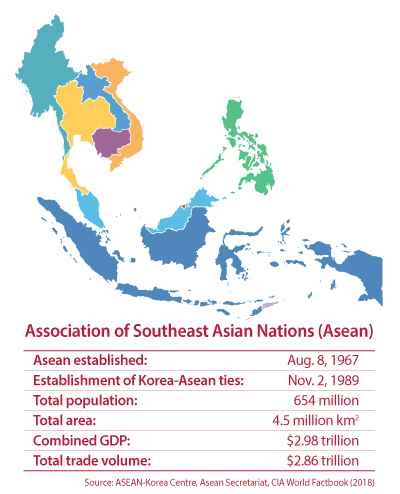
Asean was first established in 1967 and is now comprised of 10 members: Brunei Darussalam, Cambodia, Indonesia, Laos, Malaysia, Myanmar, the Philippines, Singapore, Thailand and Vietnam.
On Nov. 2, 1989, South Korean Foreign Minister Choi Ho-joong and Indonesian Foreign Minister Ali Alatas, chairman of the Asean standing committee, exchanged documents establishing sectoral dialogue relations in Jakarta, Indonesia.
Since then, the relationship was elevated to a full dialogue partnership in 1991, a comprehensive cooperation agreement in 2004 and a strategic partnership in 2010.
This year marks the 30th anniversary of relations between South Korea and Asean. Collectively, Asean has a combined GDP of $2.98 billion and a total population of over 654 million.
Asean has emerged as South Korea’s second-largest trading partner with a total trade volume of $159.74 billion in 2018, with $100.11 billion in exports and $59.63 billion in imports. This is more than double the total trade volume of a decade ago, which stood at $75 billion in 2009.
South Korea has actively pursued political and security cooperation with Asean, which has emerged a leader of diplomatic cooperation in the Asia-Pacific region.
The Asian financial crisis in 1997 was a key impetus for bolstering regional cooperation and the Asean Plus Three summit, with South Korea, China and Japan, and the Asean-South Korea Summit was launched that year.
In 1994, the Asean Regional Forum (ARF) was launched and has become a major security conference in the Asia-Pacific region which now involves all the members of the currently defunct six party nations for denuclearization talks with Pyongyang — China, Japan, Russia, the United States and the two Koreas. Global leaders also gather for the annual East Asia Summit which convenes alongside the ARF.
All 10 Asean countries maintain diplomatic relations with North Korea, leading to expectations that Southeast Asian nations can serve as models for reform following Pyongyang’s denuclearization.
South Korea has actively participated in Asean-led mechanisms and platforms while also expanding trade and cultural exchanges.
From 1987 to 2017, South Korea extended $1.8 billion in official development assistance grants and $2.6 billion in loans to Asean countries.
South Korea also invested $8.59 billion in Asean last year, while Asean invested $1.54 billion. Between 2013 and 2018, South Korea invested a total of $93.5 billion in Asean. Asean has an average estimated growth rate of 5 percent, with countries like Vietnam and Cambodia with an estimated growth rate of over 7 percent.
The South Korea-Asean free trade agreement (FTA) entered into force in 2007, and Seoul has also been pursuing bilateral FTAs with individual Southeast Asian countries.
Asean has embraced the Korean Wave, or Hallyu, while Southeast Asia is the most popular travel destination for South Koreans, with a total of 11.4 million total people traveling between Korea and Asean last year. There were 8.98 million Korean travelers visiting Asean countries and 2.46 million Southeast Asian visitors to Korea in 2018.
South Korea established its mission to Asean in Jakarta, Indonesia, in 2012, where the Asean Secretariat is located, an indication of Seoul’s diplomatic outreach to the region. Likewise the Asean-Korea Centre, an intergovernmental organization in Seoul, was launched in 2009, and the Asean Culture House was opened in Busan in 2017.
The New Southern Policy was unveiled by the Moon Jae-in administration in 2017 as a vision of economic and diplomatic cooperation with Asean and India. It places South Korea’s relations with Asean on par with the big four countries, the United States, China, Japan and Russia, and is seen as a way of diversify Seoul's diplomatic portfolio. The policy is built on the “three pillars” of “People, Prosperity, and Peace,” which also corresponds with the three pillars of the Asean Community unveiled in 2015 which are the political and security community, the economic community and the sociocultural community.
South Korea hosted the first special summit marking the 20th anniversary of relations with Asean on Jeju Island in 2009. The second special summit marking the 25th anniversary was held in Busan in 2014.
The third special summit, the 2019 Asean-Republic of Korea Commemorative Summit, will be held on Nov. 25 and 26 in Busan. The 1st Mekong-Korea Summit will take place the following day on Nov. 27, involving the countries along the Mekong River: Cambodia, Laos, Myanmar, Thailand and Vietnam. The special summit is expected to look back on the 30 years of South Korea’s relations with Asean and plan ahead for the coming decades.
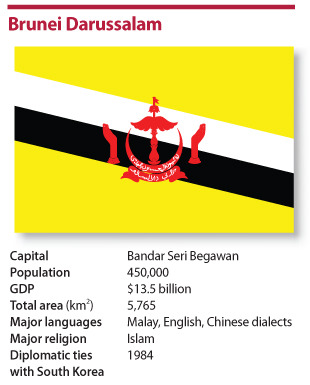
Brunei Darussalam became Asean’s sixth member on Jan. 7, 1984, right after the country gained independence from Britain. South Korea and Brunei established diplomatic relations the same year. South Korea established its consulate general in Bandar Seri Begawan, the capital city of the nation located on the island of Borneo, in September 1983, and this became ambassadorial level on Jan. 1, 1984.
Bilateral trade between the two countries last year amounted to $670 million, with exports to Brunei being $60 million and imports being $610 million. Crude oil and natural gas production accounts for more than 95 percent of Brunei’s exports and around 65 percent of its GDP. South Korea imports over 1 million tons or about 4.3 percent of its liquefied natural gas (LNG) supply from Brunei annually.
In 2018, 15,785 South Koreans visited Brunei, while 4,893 Bruneians visited South Korea, according to the South Korean Ministry of Foreign Affairs.
The Brunei Vision 2035 is the country’s long-term economic development plan to create new growth engines and has eight strategies covering areas including education, economy, security and infrastructure development. During President Moon Jae-in’s state visit to the country in March, the two sides agreed to advance cooperation in information and communication technology, smart cities and renewable energy and defense.

Bilateral diplomatic relations between South Korea and Cambodia were established on Oct. 30, 1997 after an official state visit by Cambodian Prime Minister Hun Sen to Seoul in 1996. However, the history of bilateral relations can be traced to 1970 when the U.S.-backed Lon Nol government came to power. A South Korean Embassy in Cambodia was established in 1970, but that embassy was closed as the bilateral relationship was severed when the Khmer Rouge came to power in 1975. Cambodia joined Asean in April 30, 1999. In 1998, the South Korean Representative's Office in Cambodia was elevated to an embassy, and in 2001, the Cambodian Embassy in South Korea was established.
Bilateral trade between the two countries last year rose by 11 percent and amounted to $970 million. Korean exports to Cambodia amounted to $660 million, and imports were at $310 million in 2018. Investments came to a cumulative total of $5.8 billion as of 2018. More than 300 South Korean companies are doing business in Cambodia.
In 2018, there were 301,770 South Korean visitors to Cambodia and 36,780 Cambodian visitors to South Korea, according to the South Korean Ministry of Foreign Affairs. Likewise, there were 11,969 South Koreans living in Cambodia and 47,012 Cambodians living in South Korea as of 2018.
The South Korean government invested $632 million in development cooperation in Cambodia from 1996 to 2018. From 2019 to 2023, South Korea plans to provide an additional $200 million in concessional loans.

Indonesia and South Korea established diplomatic relations on Sept. 17, 1973. However, the two countries’ consular-level relationship dates back to August 1966. Indonesia is one of the five Asean founding members that signed the Bangkok Declaration in 1967. Jakarta is also the host of the Asean Secretariat established in February 1976. The Mission of the Republic of Korea to Asean was established on October 2012 in Jakarta.
During a state visit to Jakarta in November 2017, South Korean President Moon Jae-in and Indonesian President Joko Widodo agreed to elevate the two countries’ bilateral relations to a special strategic partnership through the “Korea-Indonesia Joint Vision Statement for Co-Prosperity and Peace." The vision statement focuses on four areas of cooperation: defense and foreign affairs, bilateral trade and infrastructure development, people-to-people exchanges and regional and global cooperation. In 2012, Indonesia and South Korea agreed to establish the Indonesia-ROK Comprehensive Economic Partnership (IK-CEPA) to increase trade and economic relations.
In October this year, South Korea reached a preliminary agreement with Indonesia on the Comprehensive Economic Partnership Agreement ahead of the conclusion of a final deal within this year.
Bilateral trade between the two countries last year amounted to $19.9 billion. South Korean exports to Indonesia amounted to $8.8 billion, and imports were $11.1 billion in 2018. In 2018, there were 358,527 South Korean visitors to Indonesia, and 250,248 Indonesian visitors to South Korea, according to the South Korean Ministry of Foreign Affairs. There were 22,084 South Koreans living in Indonesia and 47,366 Indonesians living in South Korea as of 2018.
South Korea and Indonesia are also members of Mikta, a group of middle powers in the G20.

Laos and South Korea established diplomatic relations in June 1974, but they were severed the following year after the takeover by the Communist Pathet Lao movement. The two countries reestablished diplomatic relations on Oct. 25, 1995. Laos, along with Myanmar, joined Asean on July 23, 1997.
Laos envisions becoming the "battery of Southeast Asia" with its strategic location sitting on the Mekong River, which flows through 1,835 kilometers (1,140 miles) of the country from its north to its south, and having invested heavily in hydroelectric power and building dams on the main stream and its tributaries.
Bilateral trade between the two countries last year amounted to $114.1 million. Bilateral trade rose by 11 percent last year. South Korean exports to Laos amounted to $84 million, and imports were at $30.1 million in 2018. In 2018, there were 174,405 South Korean visitors to Laos and 12,394 Laotian visitors to South Korea, according to the South Korean Ministry of Foreign Affairs. Likewise, there were 3,050 South Koreans living in Laos and 1,568 Laotians living in South Korea as of 2018.
South Korea plans to offer $500 million to Laos through the Economic Development Cooperation Fund between 2020 and 2023. South Korean investment in Laos ranks fifth in foreign direct investment at $270 million in 39 projects from 2010 to 2018.

Next year will mark 60 years of diplomatic relations between South Korea and Malaysia, whose diplomatic relations were established on Feb. 23, 1960. Malaysia is one of the five Asean founding members that signed the Bangkok Declaration in 1967.
Malaysia is reviving and upgrading its “Look East Policy,” directed toward South Korea and Japan, first introduced in 1982 by Malaysian Prime Minister Mahathir Mohamad.
Malaysia has seen an annual growth of over 5 percent on average. Bilateral trade between South Korea and Malaysia last year amounted to $19.2 billion.
South Korean exports to Indonesia amounted to $9 billion, and imports were at $10.2 billion in 2018. South Korean investments in Malaysia between 1968 and 2018 came to a total of $8.2 billion, while Malaysian investments in South Korea during the same period amounted to some $7.9 billion.
In 2018, there were 616,783 South Korean visitors to Malaysia and 383,467 Malaysian visitors to South Korea. There were 20,861 South Koreans living in Malaysia and 12,227 Malaysians living in South Korea as of last year.
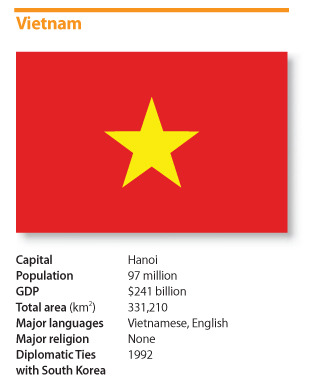
South Korea and Vietnam established diplomatic relations on Dec. 22, 1992. Vietnam joined Asean as the seventh member on July 28, 1995.
In 2009, Vietnam and South Korea upgraded their bilateral relationship to a strategic cooperative partnership. The South Korea-Vietnam free trade agreement (FTA) came into effect in December 2015, expanding economic cooperation between the two countries. After the FTA went into effect, South Korea is now Vietnam's second-largest trading partner, and Vietnam is South Korea's fourth-largest trading partner after China, the United States and Japan.
The total bilateral trade volume last year amounted to $68.3 billion, compared to $500 million in 1992 when they first established diplomatic relations. South Korean exports to Vietnam amounted to $48.6 billion, and imports were at $19.6 billion in 2018. Vietnam’s estimated economic growth rate is over 7 percent.
Vietnam is also a popular tourist destination for South Korea. In 2018, over 3.45 million South Korean visitors went to Vietnam, up 44 percent from the previous year, while there were 519,448 Vietnamese visitors to South Korea, according to the South Korean Ministry of Foreign Affairs. There were 172,684 Koreans living in Vietnam — including breakout star, Park Hang-seo, who recently renewed his contract as coach to the Vietnamese men's national football team — in 2018. Likewise, 196,633 Vietnamese were living in South Korea as of last year. Vietnam is also home to more than 7,000 South Korean companies.
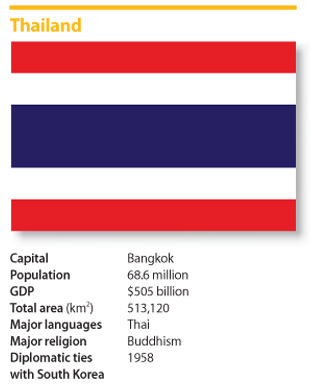
Thailand was the second nation after the United States to send troops to support South Korea during the 1950-53 Korean War, deploying over 6300 soldiers. The Thai casualties included over 130 dead and hundreds more who were wounded. Thailand and South Korea established diplomatic relations on Oct. 1, 1958, through the issuing of a joint communiqué. However, ties between the countries can be traced back to the late 14th century, when Siamese envoys were granted an audience with King Gongyang, the last king of the Goryeo Dynasty (918-1392).
Asean was founded on Aug. 8, 1967, in Bangkok, and Thailand is one of the five Asean founding members along with Indonesia, Malaysia, the Philippines and Singapore that signed the Bangkok Declaration.
Bilateral trade between the two countries last year amounted to $14.1 billion. South Korean exports to Thailand amounted to $8.5 billion, and imports were at $5.6 billion in 2018. More than 400 South Korean firms do business in Thailand, the second-largest economy in Southeast Asia after Indonesia.
In 2018, more than 1.78 million visitors traveled from South Korea to Thailand, while there were 565,784 Thai visitors to South Korea, according to the South Korean Ministry of Foreign Affairs. Likewise, there were 20,123 South Koreans living in Thailand and 197,764 Thai people living in South Korea as of last year.
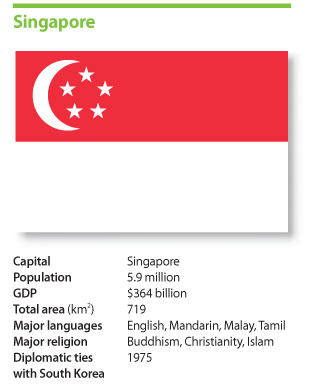
Singapore, slightly bigger in size than South Korea’s capital city of Seoul, is one of the five Asean founding members that signed the Bangkok Declaration in 1967. Singapore and South Korea established formal diplomatic relations on Aug. 8, 1975. However, over a decade before that, South Korea established a trade office, the Korea Trade Centre, in 1964 and a consulate general in 1971.
The South Korea-Singapore free trade agreement took effect in 2006, a key milestone in bilateral relations. Bilateral trade between the two countries last year amounted to over $19.8 billion. South Korean exports to Singapore reached $11.8 billion, and imports were at $8 billion in 2018. Investment amounted to a cumulative total of $5.6 billion as of 2018. In 2018, South Korea was Singapore’s 9th-largest trading partner and Singapore was the 6th largest investor in South Korea.
In 2018, 629,451 South Korean visitors travelled to Singapore, while there were 232,359 Singaporean visitors to South Korea, according to the South Korean Ministry of Foreign Affairs. Likewise, there were 20,959 South Koreans living in Singapore and 6,281 Singaporeans living in South Korea.
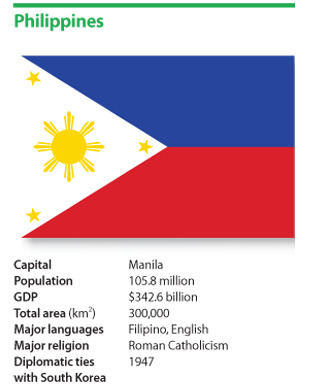
Along with the 30th anniversary of South Korea-Asean ties, this year also marks the 70th anniversary of diplomatic relations between the Philippines and South Korea. Bilateral relations between South Korea and the Philippines date back to March 3, 1949, when the Philippines became the fifth state to recognize the Republic of Korea as a sovereign state. It was the first Asean country to establish relations with the Republic of Korea after liberation from Japanese colonial rule on Aug. 15, 1948. The Philippines deployed around 7,400 soldiers to help the South during the Korean War.
After the armistice agreement ending the war, South Korea sent its first ambassador to the Philippines in January 1954, and in May that year, the Philippines established a legation in Seoul. The Philippine Embassy in Seoul opened four years later in 1958 under Ambassador Eduardo Quintero. The Philippines is also one of the five Asean founding members that signed the Bangkok Declaration in 1967.
Bilateral trade between the two countries last year amounted to $15.6 billion. South Korean exports to the Philippines amounted to $12 billion, and imports were $3.6 billion in 2018. South Korea is the fourth-largest trading partner of the Philippines. Investments amount to a cumulative total of $5.6 billion as of 2018.
The two countries also boast robust people-to-people exchanges, and in 2018, the largest number of South Koreans who travelled overseas took trips to the Philippines at over 1.58 million visitors, while there were 471,532 Filipino visitors to South Korea, according to the South Korean Ministry of Foreign Affairs. There were 85,103 South Koreans living in the Philippines and 85,103 Filipinos living in Korea.

Myanmar, a country rich in natural resources that borders China and India, provided South Korea with some $50,000 worth of rice during the 1950-53 Korean War. Diplomatic relations between South Korea and Myanmar were established on May 16, 1975. Myanmar along with Laos joined Asean on July 23, 1997.
Bilateral trade between the two countries last year amounted to $1.07 billion, with nearly equal trade and export volumes. Investment came to a cumulative total of $5.7 billion as of 2018. South Korea is the sixth-largest foreign investor in Myanmar.
In 2018, there were 72,852 South Korean visitors to Myanmar and 71,517 Burmese visitors to South Korea, according the South Korean Ministry of Foreign Affairs. Likewise, there were 3,860 South Koreans living in Myanmar and 28,074 Burmese people living in South Korea as of last year.
Myanmar, with over 55 million people, has a relatively young population with about half the population under the age of 30.
South Korea plans to double its aid for Myanmar through the Economic Development Cooperation Fund to $1 billion between 2018 and 2022, in comparison to the previous five years. South Korea is helping to build the Korea-Myanmar Friendship Bridge over the Yangon River, linking downtown Yangon to Dala Township. The two countries are also planning the Korea-Myanmar Industrial Complex, a joint industrial complex in Hlegu Township, north of Yangon.
BY SARAH KIM [kim.sarah@joongang.co.kr]










with the Korea JoongAng Daily
To write comments, please log in to one of the accounts.
Standards Board Policy (0/250자)